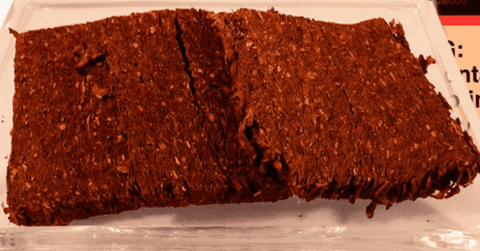Thin or Thick Pipe Tobacco?

There is something undeniably special about smoking tobacco out of a pipe. The flavor profile of pipe tobacco, combined with the act of handling a beautifully crafted pipe, can be deeply gratifying in ways that other forms of smoking just can’t compare.
Starting up a pipe-smoking hobby requires some basic knowledge of pipe tobacco, as it differs from other types of tobacco that many of us are used to. Besides the importance of understanding different types of tobaccos and their flavor profiles, it’s crucial to recognize the different types of pipe tobacco cuts available, and how their thickness levels can impact the way in which you experience your smoke.
What are the Most Common Types of Tobacco Cuts?
Many beginners don’t realize what a wide variety of pipe tobacco cuts there are, or just how much they influence the way in which we enjoy our smoking hobby. The fact of the matter is that the cut of tobacco you choose plays a huge role in multiple aspects of your smoking sessions.
Ribbon Cut
Easily, the most recognizable type of pipe tobacco is the ribbon cut, as it’s the most widely available. Ribbon cut tobacco has the appearance of small tobacco strands, and it’s extremely easy to load into a pipe due to its consistency. Ribbon cut tobacco also ages very easily as there is smaller surface area as a result of its shape, which means that you can get a deeper, richer flavor profile in a shorter period of time. However, after about a year, it’s aging potential is maxed out.
Shag
Shag tobacco is even thinner than ribbon cut. The strands are longer and skinnier, and therefore the aging process is sped up even more. It has a lower moisture level because the skinnier strands have a harder time retaining moisture. It’s also extremely lightweight when handled. Like ribbon cut tobacco, shag tobacco ages for about a year before reaching its full potential.
Ready Rubbed
Ready rubbed tobacco is another option, and it looks like thin flakes of tobacco that have been pressed together. It’s thicker and heavier than ribbon cut and shag tobacco, and results from loosely pressing the tobacco into flakes that are then cut and rubbed vigorously.
Cube Cut
Cube cut tobacco has the appearance of small, dense cubes. To make cube cut tobacco, flakes of tobacco are pressed and then cut with small scissors. Cube cut tobacco ages more gradually than thinner cuts of tobacco, but the aging process can go on for years to develop an even richer flavor profile.
Curly Cut
Curly cut tobacco is relatively thick and gets its name from its curly strands. It comes from twisting rope tobacco and making small coils. Curly cut tobacco ages beautifully while still being relatively easy to pinch and load into the bowl of a pipe.
Thinner Pipe Tobacco (Ribbon Cut, Shag)
Pros:
#1: Great Flavor Variety
With thin pipe tobacco, you’re likely to get a lot more variety of flavor with each smoking session. That’s because each pinch contains multiple tobaccos blended together evenly.
#2: Easy to Load
There’s no doubt that thinner tobacco is easier to work with. It’s easier to pinch, and easier to load into the bowl of your pipe. Therefore, it’s great for beginners who are just starting to get a feel for the process of loading a pipe with tobacco.
#3: Lots of Smoke
Because of the way in which thin tobacco is cut, it allows for more airflow in your bowl, which can result in more smoke. If you’re someone who craves a lot of smoke, then a thinner cut may be best for you.
Cons:
#1: Burns Faster
Because of the thinness of these cuts, they burn more quickly. As a result, you’ll get fewer puffs of smoke at the end of the day than you would with a thicker tobacco.
#2: Limited Aging Capabilities
Thinner tobaccos typically stop aging after about a year, which means that there is a limit as to how much that flavor can develop over time.
#3: Dries Out More Easily
Also, because the tobacco is thinner, it has a harder time retaining moisture, which means that it’s more likely to dry out if you’re not properly storing it or using it quickly enough.
Thicker Pipe Tobacco (Cube Cut, Curly Cut)
Pros:
#1: More Aging Potential
There are a lot of pipe tobacco connoisseurs who desire thick tobacco solely because of its ability to age for years, developing a darker and more intense flavor profile over time.
#2: Burns More Slowly
Thicker tobacco burns more slowly because there is more surface area to burn. Therefore, one can take their time when smoking a pipe filled with thick tobacco.
#3: Better at Retaining Moisture
Due to its thickness level, this type of tobacco retains moisture better, making it less likely to dry out.
Cons:
#1: Harder to Load
Of course, a thicker cut of tobacco will take a little more finesse when it comes to loading your pipe. Still, tobacco users get the hang of this very quickly.
#2: Less Airflow
Because the tobacco is thicker, there is less airflow resulting from the density, which means that you may get less smoke with each puff than you would with thinner cuts.
The Pipe Tobacco Size Choice is Yours!
Ultimately, each tobacco cut exists for a reason, and comes with its unique benefits that smokers can enjoy. Therefore, we encourage you to try out different tobacco cuts for yourself and see how they compare with one another. You might be surprised by which tobacco cuts you end up favoring, espeically in the long run.← Older Post Newer Post →
